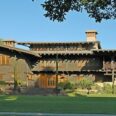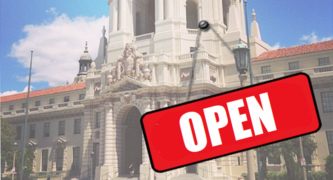No definitive answers are expected to emerge from Monday’s Pasadena City Council meeting as to when stay-at-home orders and other COVID-19-related restrictions might be lifted in the city.
Still, what is expected to be one of the lengthiest segments of another lengthy council session will focus on how the city plans to move forward, with an eye toward gradually returning to some form of quasi-normalcy.
Emphasis on “gradually.”
“Discussion of the framework for decision-making authority and parameters for reopening the economy” is the particular agenda item that figures to dominate the discussion as the council meets by teleconference beginning at 2 p.m.
A live stream of the meeting is available at www.pasadenamedia.org, and at www.cityofpasadena.net/commissions/agendas.
“The context of this discussion involves questions about the process for the city to, where appropriate, ease restrictions and allow residents and businesses to gradually transition away from restrictions imposed as a result of COVID-19,’’ according to a staff report.
For now, Pasadena remains under the state’s “Safer at Home” guidelines, per the direction of Dr. Ying-Ying Goh, the city’s health officer.
“Pasadena has the option of imposing restrictions … which are as strict, or more strict, than the state,’’ the staff report says. “Of note, the Pasadena health officer has incorporated the state’s listing of nonessential businesses in her March 22 Revised Safer at Home Order. Nonetheless, the state’s restrictions currently apply, even in the absence of the Pasadena Health Officer’s Safer at Home Order.
“For example, Pasadena cannot ‘open’ non-essential retail businesses, or ‘allow’ sit-down dining, because those activities are currently prohibited by the state public health officer’s March 19 order, as well as Gov. (Gavin) Newsom’s March 19 executive order.’’
Newsom last week outlined a four-step plan – notably, without a specific timetable — under which the state could soon begin easing shutdown restrictions, starting with businesses deemed less at risk of spreading the coronavirus, should they reopen.
“We believe we are weeks, not months, away from making meaningful modifications” of the current guidelines, Newsom said last Tuesday.
The governor, who has recently been the target of angry protests, notably in Orange County, to immediately ease certain restrictions, also said last Tuesday, “Politics will not drive our decision-making. Protests won’t drive our decision-making. Political pressure will not drive our decision-making.”
Some states, such as Georgia, and a few rural California counties have begun to relax stay-at-home restrictions and allow businesses to reopen.
But Newsom is holding to his plan, saying last week, “The only thing that’s going to hold us back (from easing restrictions) is the spread of this virus. And the only thing that is sure to advance the spread of the virus is thousands of people gathering together. Practicing social distancing or physical distance, we can avoid that.”
L.A. County health officials on Saturday announced 38 more deaths from the coronavirus and 691 additional cases, bringing the county’s totals to 24,894 cases and 1,209 deaths. Pasadena, meanwhile, reported 54 deaths and 417 total cases.
The state – and by extension, Pasadena – is still in Stage 1 of Newsom’s four-step plan. As outlined in the City Council staff report, those stages are:
* Stage 1: “Safety and preparedness: Making essential workforce environment as safe as possible.’’
* Stage 2: “Lower-risk workplaces: Creating opportunities for lower-risk sectors to adapt and re-open. Modified School programs and childcare reopen.’’
According to the city staff report, “While no particular timetable was provided, the governor indicated that if current positive trends continue, the state could move to Stage 2, the gradual opening of some lower risk workplaces with adaptations, in a matter of weeks.’’
That would include, the city report says, “retail locations, manufacturing, offices (where telework is not possible) and the opening of more public spaces. The types of adaptations that would be required to reopen businesses and offices would likely be the same or similar to protocols placed into effect for essential businesses under the current health orders.
“For example, requirements for face coverings when entering businesses, measures to protect employee health, measures to keep people properly spaced and avoid crowds,’’ the report goes on.
“Another example that was discussed in the governor’s presentation would be providing for curbside pick-up for retail locations.’’
* Stage 3: “Higher-risk workplaces: Creating opportunities for higher-risk sectors to adapt and reopen.’’
These workplaces, according to the report, include personal-care establishments such as hair and nail salons and gym; entertainment venues such as movie theaters; and sports venues, though without live audiences.
* Stage 4: “End of Stay-At-Home Order: Return to expanded workforce in highest risk workplaces. Requires Therapeutics (e.g., a COVID-19 vaccine).’’
According to the city report, this step would include large gatherings such as concerts, conventions and live sporting events. However, the report cautions, “In terms of timing, the governor stated that Stage 4 would be measured in months … (and) some are projecting that live audience sports and concert events may not return for up to a year.’’
Wider Indicators that would influence when the state might move from step to step were outlined by Newsome on April 28. They include:
* Ability to test, contact trace, isolate, and support the exposed.
* Ability to protect those at high risk for COVID-19.
* Surge capacity for hospital and health systems.
* Therapeutic development to meet the demand.
* Ability of businesses, schools and childcare facilities to support physical distancing.
* Determination of when to reinstitute measure like Stay-At-Home.
According to the city staff report, “The landscape continues to change as the state and other jurisdictions gain more experience and encounter different situations, and the regulations and requirements continue to evolve.’’
The city report also notes that, “In regard to recreational activities, at his daily press conference held on April 30, the governor announced revisions to state’s Stay-At-Home order as it relates to outdoor recreational activities.’’
“These revisions included a non-exhaustive list of outdoor activities such as golf (singles only, walking only), hiking (trails/paths allowing distancing), jogging and running that are permitted provided participants gather only with members of their own household and maintain a safe physical distance of six feet,’’ the report says.
The possibility of reopening the Rose Bowl loop was the subject of some lengthy discussion at the previous council session, and that topic is likely to arise again on Monday.
“Staff is currently reviewing these (the governor’s) revisions to determine whether the reopening of certain recreational areas within the city can occur safely,’’ the city report said.
The full city staff report is available at: http://ww2.cityofpasadena.net/councilagendas/2020%20Agendas/May_04_20/AR%201D.pdf
Monday’s full council agenda can be viewed at: http://ww2.cityofpasadena.net/councilagendas/2020%20Agendas/May_04_20/agenda.asp
***
The council will also hear a report from City Manager Steve Mermell on the city’s ongoing efforts to help local businesses that have been devastated by the COVID-related shutdowns.
“In anticipation of a shift to Stage 2 of the governor’s reopening plan, city staff, led by the Economic Development Division of the City Manager’s Office, will be organizing new outreach and engagement with various businesses sectors,’’ according to another staff report.
“The purpose of this effort will be to identify how the city can assist with reopening efforts through the identification and resolution of issues unique to various types of businesses. The groups will likely be organized as follows: 1) storefronts/retailers; 2) restaurants; 3) office R&D tenants and manufacturing; 4) schools/universities; 5) medical/dental offices; and 6) hotels and event venues.’’














 0 comments
0 comments



